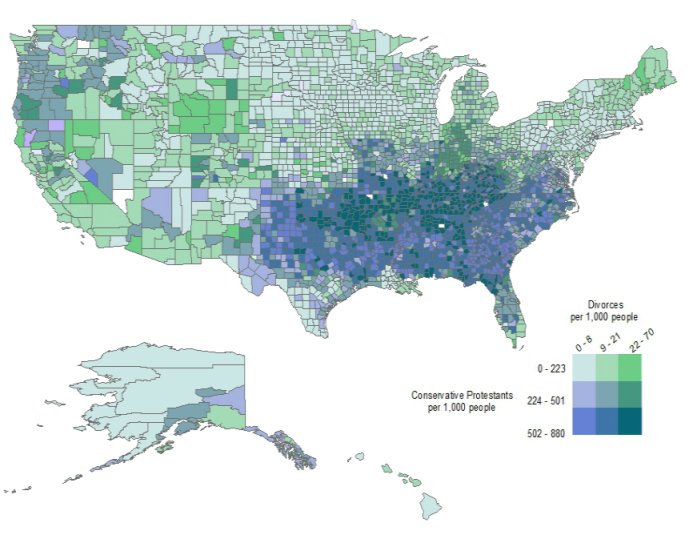The above map is based on a study that appears to show a pretty strong correlation between conservative Protestants and divorce. The study’s authors look at some possible causes and come to the conclusion that:
Unpacking these variations, Glass and Levchak found that the high divorce rate among conservative religious groups is indeed explained in large part by the earlier ages at first marriage and first birth, and the lower educational attainment and lower incomes of conservative Protestant youth.
Explains Glass, “Restricting sexual activity to marriage and encouraging large families seem to make young people start families earlier in life, even though that may not be best for the long-term survival of those marriages.”
Now we Mormons restrict sexual activity to marriage and encourage large families, yet the map seems to show that divorce rates are pretty low (relatively) in heavily Mormon counties of Utah and Idaho. The entire study has not come out yet. I am interested in seeing if the authors considered conservative Mormons at all. I will email this link to the study’s authors and see if I get anything back.
Comments?



New Post: High divorce rates among conservative Protestants. What about Mormons?: The above map … http://t.co/Rk0YuPmy9y #LDS #Mormon
TheMillennialStar: High divorce rates among conservative Protestants. What about Mormons? http://t.co/M6e2z4pC79 #lds #mormon
It would appear that Mormons don’t qualify as “conservative Protestants”, since the map shows less than 2.1% of Utah fits the bill. I’d wonder at what the qualifications were for religion, and even at themethods used for detereming the amount of religion in an area.
What really concerns me, however, is the inclusion of “even living amoungst these people raised divorce rates”.
Prof. Jennifer Glass (one of the authors of the study) wrote back the following:
Mormon concentration in counties actually has a positive net effect on divorce in my earlier analyses (not published), and simply holding a Mormon affiliation at the individual level also increases divorce risk.
That said, these results appear to be the result of early interfaith marriages of Mormons and non-Mormons. When both partners are Mormons and participate in religious activities together, their divorce risk seems to be lower than average.
Most counties have very low concentrations of Mormons, only Utah and some mountain states have significant numbers of Mormons, encouraging more intrafaith marriages there. As is stated in my article, when conservative faiths can create a “marriage cartel” in which most members of the local marriage market are co-religionists who enforce norms of premarital chastity and support early marriage, divorce risk is lower. Utah seems to exemplify this.
Unlike conservative Protestants, Mormon youth have generally high levels of educational attainment and few premarital pregnancies. Marriage and parenthood does not seem to deter educational attainment among Mormons as much as those of other faiths. Thus, these young families are in a better financial position than most. This might be, in fact, the most important difference between CP and Mormon family formation patterns.
Jennifer Glass, Ph.D.
Barbara Bush Regents Professor of Liberal Arts
Department of Sociology & Population Research Center
305 E. 23rd St., A1700
University of Texas – Austin
Austin, Texas 78712-1699
Frank, I don’t think the study or I was intending to imply that Mormons are “conservative Protestants.”
Frankly the map is hard to get the right data out of because of the colors they chose to use. They are using a 3×3 matrix with % of conservative Protestants going up and down in blue shades with the higher percentages being darker and the divorce rate going left to right in green shades with the higher percentages being darker. The problem is that 1) green and blue are really close on the color wheel, in fact green is made up of blue, and 2) just because the color is darker on the map doesn’t necessarily mean it shows higher divorce rates.
Some examples:
As you highlighted, the LDS communities in Utah and Idaho show up as lighter. But if you look closer, it shows that they are not “conservative Protestant”, the divorce rate is actually in the middle tier (with more rural Utah communities in the bottom tier). Meanwhile Wyoming has a high divorce rate, but still low “conservative Protestant” population.
As you get into the Southern Bible Belt region, the map is much darker … but mostly because the dark blue is darker than the dark green. So what it is actually showing is that the area is more Protestant. OK. No surprise. But then there is a little scattering of high divorce counties in the Protestant regions.
Meanwhile the New England area which is low in Protestants has pockets of higher divorce rates that don’t really show up because the color differences for that row are smaller. But check out the divorce rates in Maine!
I can’t see if they controlled for race or not. I also have my doubts about the income thing. I can see their story that early marriage leads to lower incomes. But its also true that the early-marrying population may simply be a population that is likely to have lower income anyhow and also happens to be more likely to be conservatively religious. That being so, you’d really need to control for income to see how much conservative Protestantism affects things.
I’m also dubious about using divorces per capita as the yardstick. Successful marriages per capita would be just as useful if not more so.
Conservative Protestants also tend to GET married, so when they split up, there is a divorce. Those just shacking up, don’t get divorced, so the divorce rates are lower in areas where this happens more. (Presumably where larger numbers of non-conservative religious folks live.)